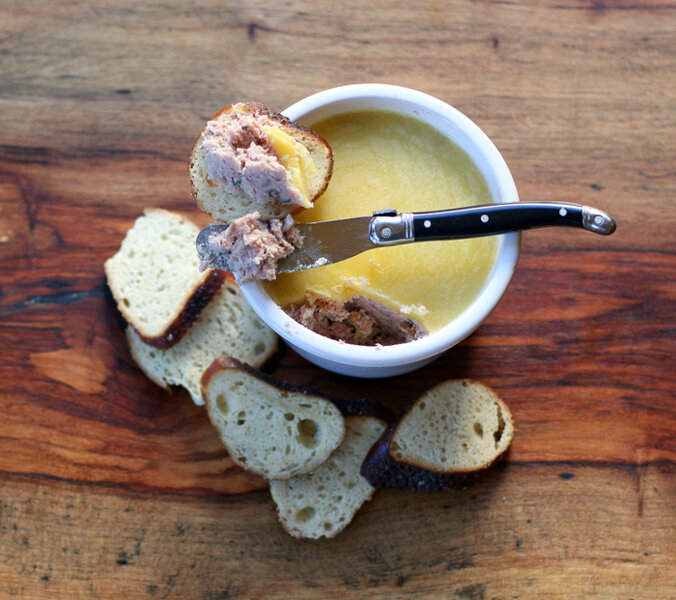Potted ham
Potted ham is some truly old fashioned cooking. Potting was a method for preserving meat and seafood and even cheese in English kitchens before the advent of refrigeration. It is basically sealing finely chopped meat under a layer of clarified butter. The butter solidifies and shields the meat form unwanted visitors.
It was the precursor to canned meats and I think that is probably why it’s reputation suffered and it went largely out of fashion. I’ve made potted shrimp and potted stilton for English themed tea parties and they’ve always been very popular, but I had never thought of potting ham until I found this recipe in Noel McMeel’s book Irish Pantry at the precise moment I had a surfeit of leftover ham in my refrigerator.
I find this dish charmingly old-fashioned, but it somehow seems to have a modern resonance and stylishness to it. It seems so homemade and self-sufficient. Make this in elegant little ramekins and serve as a first course with toasted crusty bread and a pretty little spreading knife, or make a larger ramekin (no more than a 2-cup size) and serve on a cheese platter with crackers. And it makes great sandwiches – even as a layer in a bahn-mi.
I would not trust this method as its original purpose as a long-term storage solution for meat, but it will keep in the refrigerator for up to a week. And it freezes well too. Pack it into freezable jars, cover with butter, refrigerate until cold, then freeze for up to 3 months. Thaw completely in the fridge before serving. I particularly like it in these European-style jars. I have simplified the original recipe a bit.
Potted ham
Adapted from "Irish Pantry" by Noel McMeel
8 ounces of high-quality butter (like Kerrygold)
1 pound cooked ham, torn onto pieces
1 tablespoon parsley
1 tablespoon cider vinegar
1/4 teaspoon ground cloves
1/4 teaspoon brown mustard seeds
1/4 teaspoon yellow mustard seeds
1/4 teaspoon salt
lots of ground black pepper
1. Cut the butter into quarters and place in a 4-cup microwave safe measuring jug. Microwave on high for 2 minutes. Leave the butter to sit for one minute, then skim off any white foam from the surface. Slowly and carefully pour the clarified butter into a smaller measuring jug leaving the white solids behind. Set aside.
2. Place the ham in the bowl of a food processor fitted with the steel blade and pulse several times to break the meat up into rough crumbs. Add the parsley, vinegar, cloves, mustard seeds, salt, pepper, and about 2/3 of the clarified butter. Pulse until you have a thick, rough paste that sticks together, scraping down the sides of the bowl as needed and making sure everything is well combined.
3. Use a spoon to transfer the ham to ramekins or jars. Pack the ham down lightly into the containers making sure there are no large gaps. Smooth the top of the ham to an even layer. Pour the remaining clarified butter equally over the top of each container. The surface needs to be completely covered with a generous layer of butter. No ham should be sticking up through the butter. Leave the ramekins on the counter so the butter settles and begins to solidify, then carefully transfer to the fridge. When the butter has solidified completely, cover with jar lids or plastic wrap. Let come to room temperature before serving.
The potted ham will keep in the fridge for a week or the freezer for up to three months.
Related post on The Runaway Spoon: Country Ham Paté






